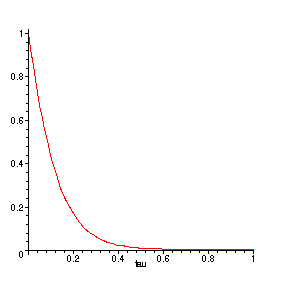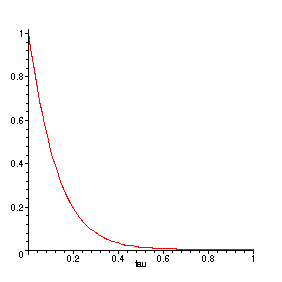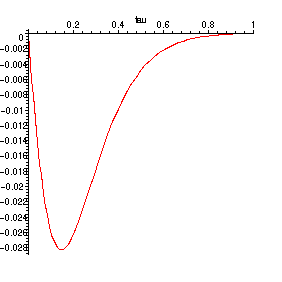Example 15.5-2 Operation of a simple Temperature Controller
> restart;
> eqliq:=diff(Ul(t),t)=Q(t)+wCpl*(Ti-T(t));
![]()
> eqcoil:=diff(Uc(t),t)=-Q(t)+Qc(t);
![]()
> Ul:=t->rVCl*(T(t)-Tbar);
![]()
> Uc:=t->rVCc*(Tc(t)-Tbar);
![]()
> Q:=t->UA*(Tc(t)-T(t));
![]()
> Qc:=t->b*(Tmax-T(t));
![]()
> eqliq; eq. 15.5-15
![]()
> eqcoil; eq. 15.5-16
![]()
> eqss:=rhs(eqliq)+rhs(eqcoil); Note that this does not include Tc(t)
![]()
> Tss:=solve(eqss,T(t)); The steady state solution for any value of Ti.
![]()
> Tinit:=subs(Ti=T0,Tss); eq. 15.5-17. This is what the book calls T(0).
![]()
> Tinf:=subs(Ti=T1,Tss); eq. 15.5-19. This is what the book calls T(infinity).
![]()
> Tcss:=solve(rhs(eqcoil),Tc(t)); The steady state for the coil for any given T(t)
![]()
> Tcinit:=simplify(subs(T(t)=Tinit,Tcss)); eq. 15.5-18, but note that T(0) which we called Tinit has not been substituted into eq. 15.5-18
![]()
> Tcinf:=simplify(subs(T(t)=Tinf,Tcss)); eq. 15.5-20 and Tinf has not been substituted into 15.5-20.
![]()
> Ti:=T1;
![]()
> tr:={T=Tinf+Theta*(T0-Tinf),Tc=Tcinf+Thetac*(Tc0-Tcinf),t=rVCl*tau/UA};
![]()
![]()
![]()
> with(PDEtools[dchange]);
![]()
> lst:={eqliq,eqcoil}; Putting the two DEs in a list. This turns out not to be useful, but does demonstrate that dchange can handle multiple equations in a single call to it.
![]()
![]()
> rVCc:=rVCl/R; wCpl:=UA*F; b:=B*UA; eq. 15.5-24. R is the ratio of the heat capacity of the tank to the coil. eq. 15.5-25. F is the ratio of the heat transfer coef to the flow heat capacity. eq. 15.5-26. B is the ratio of the control action to the heat transfer coef.
![]()
![]()
![]()
> newlst:=simplify(dchange(tr,lst,[Theta(tau),tau,Thetac(tau)]));
![[Maple Math]](images/p47626.gif)
![]()
![]()
![]()
![[Maple Math]](images/p47630.gif)
![]()
![]()
![[Maple Math]](images/p47633.gif)
> eqtheta:=simplify(newlst[1]*(F+B)/UA/(T0*(F+B)-F*T1-B*Tmax)); Here I had to look at each equation separately. Note that Maple may oder the two equations in newlst differently on different occasions.
![]()
![]()
![]()
![]()
> eqthetac:=simplify(newlst[2]*(F+B)/UA/(Tc0*(F+B)-F*T1-B*(Tmax*(1+F)-F*T1)));
![[Maple Math]](images/p47638.gif)
![]()
![]()
![]()
> simplify(coeff(rhs(eqtheta),Theta(tau))); This should be -(1+F)
![]()
> simplify(coeff(rhs(eqtheta),Thetac(tau))); This should be 1-B
![]()
> simplify(%-1+B); Here is what is left over from what we expect.
![[Maple Math]](images/p47644.gif)
> simplify(coeff(rhs(eqthetac),Theta(tau))); This should b +1
![[Maple Math]](images/p47645.gif)
> simplify(%-1); Here is what is left over from what we expect.
![[Maple Math]](images/p47646.gif)
> simplify(coeff(rhs(eqthetac),Thetac(tau))); This should be -1
![]()
> solve(rhs(eqcoil),Tc(t)); The steady state equation for Tc
![]()
> Tc0:=T0+B*Tmax-B*T0; Making Tc0 satisfy 15.5-18
![]()
> eqtheta:=simplify(eqtheta); That's better.
![]()
> eqthetac:=simplify(eqthetac); So is this.
![[Maple Math]](images/p47651.gif)
> s:=dsolve({eqtheta,eqthetac,Theta(0)=1,Thetac(0)=1},{Theta(tau),Thetac(tau)}): Here we go, but don't look. It is very long.
> assign(s); Just one of the variables is bad enough.
> Theta:=simplify(unapply(Theta(tau),tau)); We will look at Theta.
![[Maple Math]](images/p47652.gif)
![[Maple Math]](images/p47653.gif)
![[Maple Math]](images/p47654.gif)
![]()
![[Maple Math]](images/p47656.gif)
![]()
> Thetac:=unapply(Thetac(tau),tau): But not Thetac
> eq:=(1+F+R)^2-4*R*(B+F); Inspection of eq. 15.5-32 shows this should be the dividing line between oscillation and exponential behavior.
![]()
> Bcrit:=solve(eq,B);
![[Maple Math]](images/p47659.gif)
> Bcrit:=unapply(Bcrit,F,R);
![[Maple Math]](images/p47660.gif)
> Bcrit(3,20);
![]()
> Th:=unapply(Theta(tau),tau,B,F,R); Th wil be a function of tau and the three parameters: B, F, and R
![[Maple Math]](images/p47662.gif)
![[Maple Math]](images/p47663.gif)
![[Maple Math]](images/p47664.gif)
![]()
![[Maple Math]](images/p47666.gif)
![]()
> thet1:=simplify(Th(tau,22/5,3,20),assume=positive); For B>Bcrit.
![]()
![]()
> thet2:=simplify(Th(tau,20/5,3,20),assume=positive); For B<Bcrit
![]()
> thet1:=evalc(thet1); evaluating using complex relations.
![]()
> plot(thet1,tau=0...1);

> plot(thet2,tau=0...1);

> plot(thet1-thet2,tau=0...1);

>